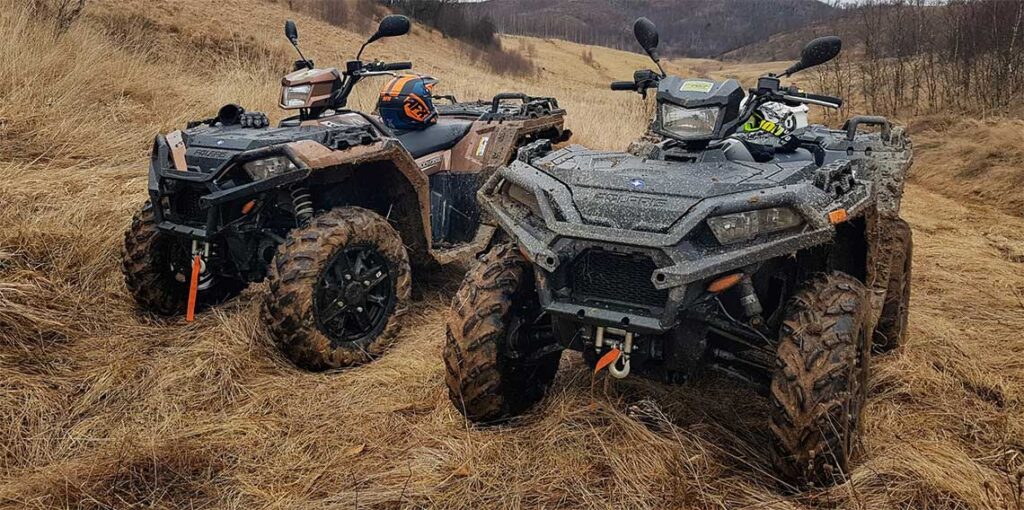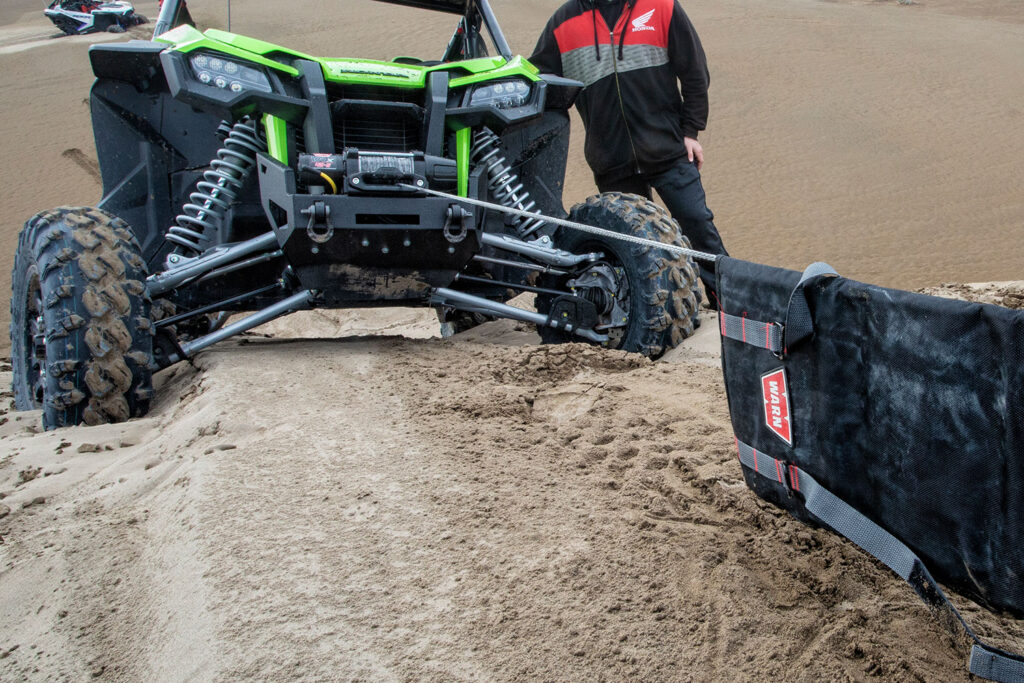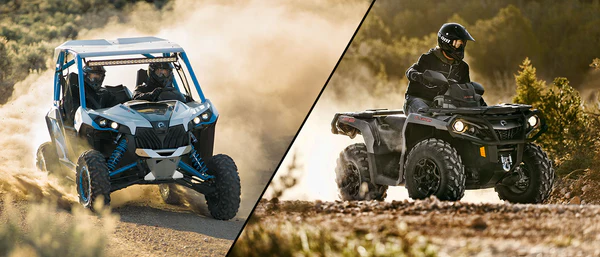Deciding between an ATV winch and a utility winch depends on the type of terrain, vehicle weight, and tasks you’ll tackle. ATV winches are ideal for recreational trail use and light recovery (1,500–4,500 lbs), while utility winches handle heavier-duty jobs like hauling equipment and farm use (4,000–12,000+ lbs). This guide breaks down the key differences so you can make the best choice for your off-road adventures.
Quick summary
ATV winches are best suited for light-duty recovery tasks and recreational trail riding, with pulling capacities ranging from 1,500 to 4,500 lbs. In contrast, utility winches are built for heavy-duty work like hauling, farming, or industrial use, with capacities starting at 4,000 lbs and going beyond 12,000 lbs. To choose the right winch, consider your vehicle’s weight, the terrain conditions, and the intensity of tasks you’ll be performing.
What is an ATV Winch and How Does It Work?

An ATV winch is a powerful tool attached to an all-terrain vehicle (ATV) to pull or lift heavy objects. Think of it as your ATV’s lifeline, perfect for getting out of tough spots like deep mud or rocky trails.
It’s not just for emergencies; ATV winches are handy for activities like hunting, farming, and trail riding, helping you move obstacles or haul equipment.
ATV Winch Features and Specifications Explained
ATV winches come with some impressive features. First, they have a sturdy rope made of steel or synthetic materials, which is strong enough to handle heavy loads. Understanding the differences in synthetic rope vs. steel cable winch options is crucial to selecting the right winch for your needs.
They are powered by a robust motor and have a gear system that ensures smooth operation. Most modern ATV winches offer remote controls, so you can operate them from a distance, making it easier and safer to use.
Additionally, many have automatic brakes that hold the load securely when you stop the winch.
What Is the Ideal Pulling Capacity for Each Winch Type?
When it comes to pulling power, ATV winches usually range from 1,500 to 4,500 pounds. This range covers most ATV recovery needs, whether you’re stuck in mud or need to haul a heavy load of game or supplies.
How much weight should your winch handle?
Answer: The pulling capacity of your winch should be at least 1.5 times the vehicle’s gross weight. This ensures safe and efficient recovery operations, accounting for additional resistance caused by mud, inclines, or obstacles. For example, if your ATV weighs 2,000 pounds, opt for a winch with at least a 3,000-pound capacity.
Mounting Options for ATVs
Mounting an ATV winch can be straightforward, with several options available to suit your ATV model. Common mounting setups include brackets for the front or rear of your ATV, giving you the flexibility to choose the best position for your needs.
What are the best mounting positions for ATV winches?
Answer: Front mounts are ideal for recovery and trail use, as they provide easier access and visibility during winching operations. Rear mounts are better suited for hauling and towing tasks, especially when moving loads behind the vehicle. Choosing the right mount depends on the primary purpose of the winch.
Understanding Utility Winches

Utility winches are the heavy-duty cousins of ATV winches. These robust devices are used for more demanding tasks, like construction work, off-road vehicle recovery, and industrial applications.
Whenever there’s a need to move or lift significantly heavier loads, a utility winch is the go-to tool.
Key Features and Specifications
Utility winches come packed with powerful motors and tough cables designed to handle substantial weight.
They feature advanced gear systems for efficient operation and often offer multiple power options, including battery, hydraulic systems, and PTO (Power Take-Off) from a vehicle’s engine.
Many utility winches also come with wireless remote controls and load-holding brakes to ensure safe and precise handling of heavy loads.
Typical Pulling Capacity Range
These winches are built for serious work, with pulling capacities starting around 4,000 pounds and going up to 12,000 pounds or more. This makes them suitable for tasks like towing vehicles, lifting construction materials, and other heavy-duty operations.
Versatility in Mounting Options
One of the great things about utility winches is their versatility in mounting. They can be fixed to vehicles, used with portable mounts, or integrated into industrial setups.
This adaptability makes them suitable for various environments and tasks, from on-site construction work to off-road rescues.
Key Differences Between ATV and UTV Winches

1. Size and Weight
Compact Nature of ATV Winches
ATV winches are designed to be compact and lightweight, making them ideal for smaller vehicles like all-terrain vehicles (ATVs).
Their compact design ensures that they do not add significant bulk or weight to the ATV, allowing it to maintain its maneuverability and performance.
The lightweight nature of these winches also means that they are easier to install and handle, which is crucial when you are out in the field or on the trails.
Larger, Heavier Build of Utility Winches
Utility winches, on the other hand, are built to be larger and heavier to handle more demanding tasks. These winches are designed for heavy-duty use, which requires a robust construction to withstand rigorous conditions.
The increased size and weight of utility winches make them suitable for larger vehicles like trucks, SUVs, and industrial machinery. Their heavy build ensures they can manage significant loads without compromising on performance or safety.
2. Pulling Capacity
ATV Winch Capacity
ATV winches typically offer a pulling capacity ranging from 1,500 to 4,500 pounds. This capacity is sufficient for most recreational and light utility purposes, such as recovering an ATV stuck in mud, hauling game during hunting trips, or moving lightweight obstacles.
The pulling capacity of ATV winches makes them versatile tools for outdoor enthusiasts who need reliable equipment for occasional heavy lifting and pulling.
Utility Winch Capacity
Utility winches boast a much higher pulling capacity, often starting at 4,000 pounds and going up to 12,000 pounds or more.
This makes them ideal for intense applications such as vehicle recovery, where they might need to pull a stranded truck or SUV out of a ditch, or for industrial use, such as lifting and moving heavy construction materials.
The higher pulling capacity ensures that utility winches can handle the most demanding tasks without failure.
3. Power Source
Battery-Powered ATV Winches
ATV winches are generally powered by the ATV’s battery. This makes them convenient to install and use, as they can be easily integrated into the ATV’s existing electrical system.
The battery-powered nature of these winches means that they are always ready for use, provided the ATV’s battery is in good condition. This setup is particularly useful for remote locations where other power sources might not be available.
Various Power Options for Utility Winches
Utility winches offer more versatility in terms of power sources. They can be powered by the vehicle’s battery, similar to ATV winches, but they also have options for hydraulic systems and Power Take-Off (PTO) from a vehicle’s engine.
These options significantly impact winch power and efficiency, making them ideal for demanding tasks.
Hydraulic winches use fluid pressure to generate power, making them highly reliable and powerful for continuous use.
PTO winches draw power directly from the vehicle’s engine, providing a robust and steady power source for the most demanding tasks.
This flexibility in power options ensures that utility winches can be adapted to various environments and requirements.
4. Durability and Weather Resistance
ATV Winches Designed for Outdoor Use
ATV winches are specifically designed to withstand outdoor conditions. They are made from weather-resistant materials and have seals to protect internal components from water, dirt, and debris.
This durability ensures that they can perform reliably in harsh environments, such as muddy trails, rainy weather, or dusty off-road conditions. The rugged design of ATV winches makes them a dependable tool for outdoor adventures.
Heavy-Duty Construction of Utility Winches
Utility winches are constructed to be even more durable, often using reinforced materials and heavy-duty designs to handle significant loads and harsh working conditions.
These winches are built to last, with features like corrosion-resistant coatings, robust gear systems, and reinforced mounting points.
Their construction ensures that they can withstand the rigors of industrial use, including exposure to extreme weather, heavy usage, and challenging environments.
5. Cost Comparison
General Price Ranges for Each Type
The cost of ATV winches generally ranges from $100 to $500. This price range makes them affordable for most ATV owners and outdoor enthusiasts who need a reliable winch for occasional use.
Utility winches, however, can range from $500 to over $2,000, depending on their capacity and features. The higher cost reflects the increased pulling capacity, advanced features, and robust construction of these winches.
Factors Affecting Price
Several factors influence the price of both ATV and utility winches. Pulling capacity is a primary factor, with higher capacities commanding higher prices.
Build quality also plays a significant role, with more durable and weather-resistant materials increasing the cost. Additional features, such as wireless remote controls, automatic brakes, and multiple power options, can also add to the price.
Lastly, the brand reputation and reliability of the winch can affect its overall cost, with well-known brands often charging a premium for their trusted products.
| Feature | ATV Winches | UTV Winches |
|---|---|---|
| Pulling Capacity | 1,500 – 4,500 lbs | 4,000 – 12,000+ lbs |
| Primary Use | Recreational and light-duty | Heavy-duty, industrial tasks |
| Vehicle Type | Lightweight vehicles (ATVs) | Heavy vehicles (UTVs, SUVs) |
| Power Source | Battery | Battery, hydraulic, or PTO |
Choosing the Right Winch for Your Needs
Which Winch Should You Choose for Your Off-Road Vehicle?
Assessing Your Vehicle Type and Weight
The first step in selecting the right winch is to carefully assess your vehicle type and its weight. This is crucial because the winch you choose must have enough pulling power to handle your vehicle, especially in recovery situations.
For ATVs, which are generally lighter, a winch with a pulling capacity of 1,500 to 4,500 pounds is usually sufficient. This range covers most scenarios where an ATV might get stuck, such as in mud or on a steep incline.
For larger vehicles like trucks, SUVs, or industrial machinery, you’ll need a winch with a higher capacity. Utility winches, which can handle between 4,000 to 12,000 pounds or more, are suitable for these heavier vehicles.
It’s important to know your vehicle’s gross weight and choose a winch that can handle at least 1.5 times that weight to ensure it can pull the vehicle out of challenging situations without strain.
Considering Typical Usage Scenarios
Next, consider how you will be using the winch. If you’re using the winch primarily for occasional recreational activities, like off-roading with an ATV, a winch with moderate capacity and basic features will suffice.
These winches are ideal for occasional recovery tasks and light-duty hauling.
However, if your activities involve frequent heavy-duty tasks, such as industrial towing, construction, or off-road vehicle recovery, you will need a utility winch with higher capacity and more robust features.
Utility winches designed for heavy-duty use come with reinforced components, higher pulling capacities, and additional features like wireless remote controls and load-holding brakes, making them suitable for demanding applications.
Evaluating Terrain and Environmental Factors
The terrain and environmental conditions in which you plan to use the winch are also crucial factors to consider. Different terrains present different challenges, and the winch must be able to withstand these conditions.
For muddy, wet, or rocky areas, it’s important to choose a winch with high durability and weather resistance. Look for winches made from corrosion-resistant materials and those with seals to protect internal components from water, dirt, and debris. This ensures the winch remains functional and reliable even in harsh environments.
In environments where extreme cold or heat is a factor, make sure the winch is designed to operate efficiently under such conditions.
Some winches come with special lubricants and materials that perform well across a wide temperature range, ensuring they don’t fail when you need them the most.
Importance of Matching Winch Capacity to Vehicle Weight
One of the most critical aspects of choosing the right winch is matching its capacity to your vehicle’s weight. The winch capacity must not only match but ideally exceed the weight of your vehicle to ensure safe and efficient operation.
A good rule of thumb is to choose a winch with a capacity that is at least 1.5 times the weight of your vehicle. This provides a safety margin that accounts for additional resistance from factors like mud, inclines, and obstacles.
For example, if your vehicle weighs 4,000 pounds, you should opt for a winch with at least a 6,000-pound pulling capacity.
Overloading a winch can lead to mechanical failure, which can be dangerous and costly. Ensuring that the winch capacity is adequate for your vehicle’s weight not only enhances performance but also extends the lifespan of the winch by preventing undue strain on its components.
Installation and Maintenance
Basic Installation Process for Each Type
Installing a winch, whether for an ATV or utility purposes, involves several key steps to ensure it is secure and functional:
Mounting the Winch: Start by securely attaching the winch to your vehicle. This usually involves using specific mounting brackets designed for your ATV or utility vehicle. Ensure the mount is sturdy and properly aligned to handle the winch’s load.
Connecting the Power Source: Next, connect the winch to its power source. For ATV winches, this typically means connecting it to the ATV’s battery. Ensure the connections are tight and well-insulated to prevent electrical issues. For utility winches, you may need to connect to a battery, hydraulic system, or PTO, depending on the winch type.
Setting Up the Control System: Install the control system, which could be a wired or wireless remote. Follow the manufacturer’s instructions to properly integrate the control system, ensuring that you can operate the winch from a safe distance.
Testing the Installation: Once installed, test the winch to ensure it operates smoothly. Check that the winch motor runs correctly, the cable spools evenly, and the remote controls respond properly.
Maintenance Tips for Longevity and Performance
Regular maintenance is essential to keep your winch in top condition and extend its lifespan:
Checking the Cable for Wear: Inspect the winch cable regularly for signs of wear and tear, such as fraying or kinks. Replace the cable if it shows significant damage to prevent failures during use.
Cleaning and Lubricating: Keep the motor and gears clean and well-lubricated. Dirt and debris can cause wear on moving parts, so regular cleaning is crucial. Use appropriate lubricants recommended by the manufacturer to ensure smooth operation.
Testing the Control System: Regularly test the control system to make sure it functions correctly. This includes checking the remote controls and ensuring the winch responds as expected. Address any issues immediately to avoid operational failures.
Overall Inspection: Periodically conduct a thorough inspection of the entire winch system, including mounting points, electrical connections, and the mechanical parts. Tighten any loose bolts and ensure all components are in good working condition.
Safety Considerations
Proper Use of Winches
Using winches safely involves adhering to the manufacturer’s guidelines and taking necessary precautions:
- Avoid Overloading: Never exceed the winch’s rated capacity. Overloading can cause mechanical failures and pose safety risks.
- Use Proper Anchors: When winching, ensure the anchor point is secure and strong enough to handle the load. An unstable anchor can lead to accidents and equipment damage.
- Spool the Cable Correctly: Make sure the winch cable is spooled evenly and tightly. Loose or uneven spooling can cause the cable to tangle or slip, reducing its effectiveness and safety.
Essential Safety Gear and Precautions
When operating a winch, wearing the right safety gear and following safety protocols is vital:
- Wear Protective Gear: Always wear gloves to protect your hands from the cable, safety glasses to shield your eyes from debris, and sturdy footwear to prevent foot injuries.
- Keep Bystanders Clear: Ensure that no one stands near the winch line during operation. The winch cable can snap under tension, posing serious injury risks to bystanders.
- Use Winch Dampers: Place a winch damper (a heavy blanket or winch dampening device) over the winch cable. This reduces the risk of the cable whipping back if it breaks, adding an extra layer of safety.
Conclusion
Choosing the right winch, whether ATV or utility, depends on your specific needs and usage scenarios.
By understanding the key features, capacities, and installation requirements, you can make an informed decision that enhances your vehicle’s capabilities and ensures safe, efficient operation.
Example Use Cases:
- ATV Winches: These are perfect for trail recovery scenarios, such as pulling an ATV out of mud, over rocky terrain, or navigating difficult trails. They are also great for moving obstacles or hauling lightweight equipment during outdoor adventures.
- UTV Winches: Designed for heavier-duty tasks, UTV winches excel in hauling heavy equipment like trailers or recovering larger vehicles. For top-rated options tailored to both recreational and heavy-duty use, check out our best winches for ATV and UTV based on performance, durability, and value. They are also commonly used for lifting industrial materials in construction sites or during demanding off-road rescues.
For those looking for the best winch options for off-roading, selecting a model with high durability and weather resistance is essential.

